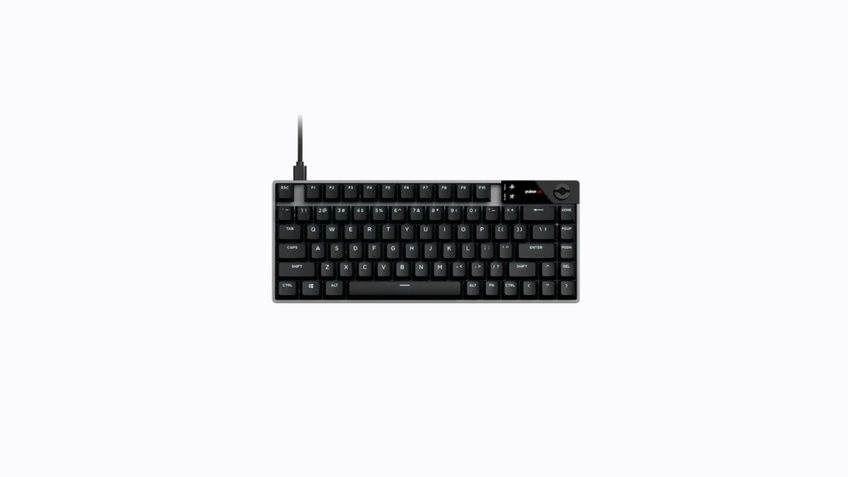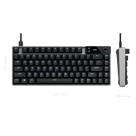Introduction
At this point, everyone knows that a good gaming keyboard is an analog keyboard. Over the past year or two, tons of interesting options have been hitting the market, to the point where it’s difficult for brands to set themselves apart. Pulsar is trying to do just that with their latest effort. Combining on-the-fly adjustments with a full-color screen in the top right, it’s certainly a rather unique option. Read our full Pulsar eS HE 70 review to find out whether it’s worth your hard-earned time and money.
At A Glance
Pulsar eS HE 70
The Pulsar eS HE 70 is an interesting idea, but I don’t feel as if it’s fully realized.
Pros
- Great typing sound and typing experience
- Looks unique and interesting
- Keycaps are nice
- Good gaming performances
Cons
- Screen section feels underutilized
- Pretty expensive
- Raesha magnetic switches don’t allow for much switch customization
Specs
| Form Factor | TKL |
|---|---|
| Switches | Raesha Magnetic Switches |
| PCB | Hotswappable |
| RGB | Yes |
| Height | 4.5cm |
| Width | 12.4cm |
| Length | 31.1cm |
| Weight | 970g |
First Impressions
Packaging
Inside the box, you get:
- Three replacement switches
- A USB-C to USB-A cable
- The keyboard itself
- User documentation
- A Pulsar sticker
- A keycap/switch-puller combo tool
That’s everything you need in a gaming keyboard box, if you ask me. The inclusion of not one, but three extra switches makes it so that you don’t have to worry about switch breakage.
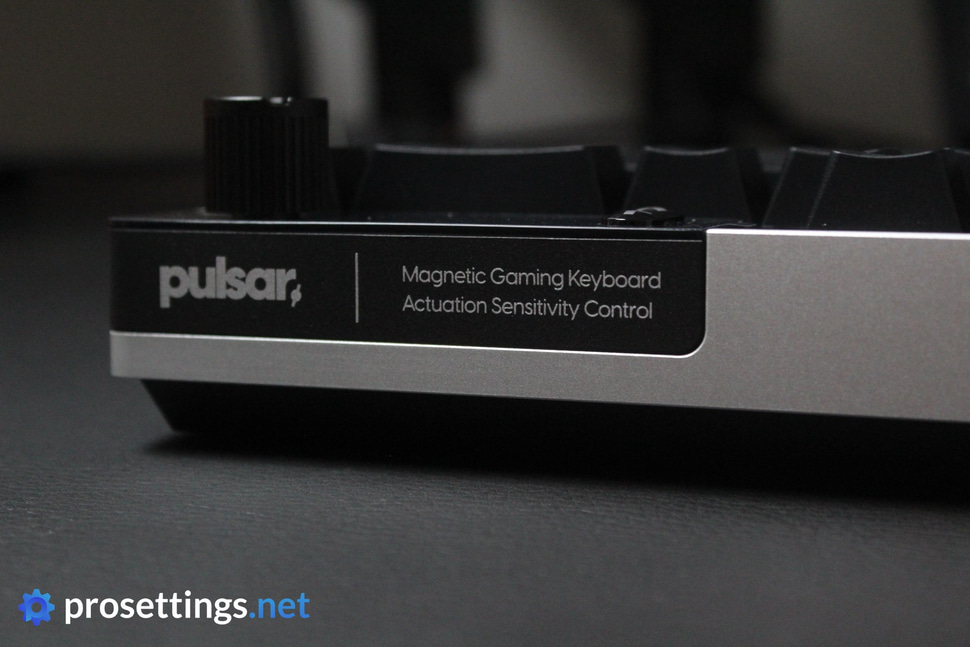
Keyboard
The Pulsar eS HE 70 is a modern-looking keyboard with its silver and black design. Obviously, the most eye-catching design element is the screen in the top right. This is a full-color display that allows you to change a whole bunch of settings on the fly. The reason for this screen being there is the fact that pros often don’t have access to the internet or don’t want to be downloading driver programs all the time, so having a screen to help them fine-tune their setup is a handy addition in that regard.
The keyboard as a whole makes a good first impression: it feels sturdy, looks high quality, and it seems like an original and interesting product.
RGB
In terms of RGB, the Pulsar eS HE 70 is quite good. It’s not the most impressive light show I’ve ever seen, but the lighting shines through the keycaps nicely and there’s a bunch of cool effects to choose from. Transitions between different colors and effects also look smooth. I have no complaints about the RGB implementation here.
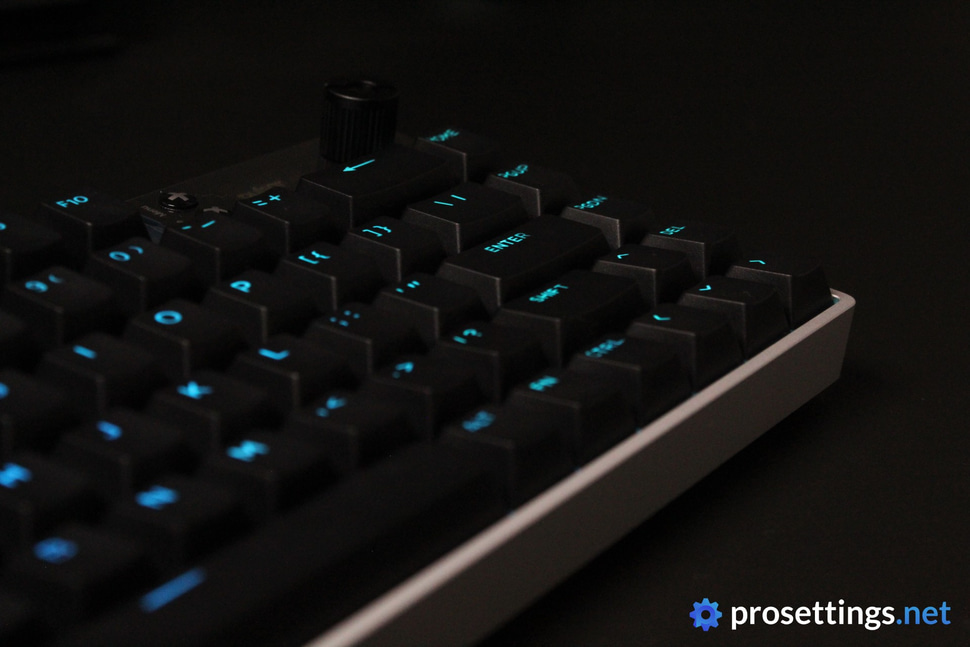
Features and Build Quality
Materials and Design
Pulsar has gone for a mixture of aluminum and plastic here. The very bottom section of the board is made out of decently thick plastic, and the top housing and backplate are CNC aluminum. I like this mixture, as it gives the board a premium look and feel without making it too heavy.
Normally, I don’t really care about the weight of a keyboard, but I mention the lighter weight since this is an esports-focused keyboard. Esports pros are traveling a lot, so they benefit from having a lighter board. With that in mind, I feel like this design is a great marriage between portability and premium looks.
Thanks to the aluminum top, the board feels very solid and sturdy. Bending it is pretty much impossible, and the whole board feels like a quality piece of equipment.
On the bottom are long rubber strips that do a great job at keeping the board in place. You’ll also find two sets of flip-up feet so that you can get the angle that you like.
LCD Display
The most notable feature is of course the LCD display. Some might call this a gimmick, but I kind of like it on performance-focused products. With so many options and configurable details being available these days, it can be good to have a quick visual indicator of what settings you’re currently on. So to me, this is definitely not a bad idea. It looks great as well. It’s sharp, and the colors are vivid.
Sadly, it feels like a bit of a missed opportunity. The screen is really handy for adjusting certain settings on the fly (more on that later) but beyond that, there’s not much to it. When you’re not adjusting anything, it just shows the Pulsar eS logo. Why is there no option to have a custom image or gif displayed there? Or, if they don’t want to go that route, why not have a few cool pre-made effects like a WPM counter or a gauge that shows how far a button is being pressed?
Obviously, these cosmetic things don’t have an influence on the performance of the product, so I won’t harp on this too much, but I feel like they missed a slam dunk here. Gamers love customization, and this beautiful high-res screen would’ve been the perfect candidate for it.
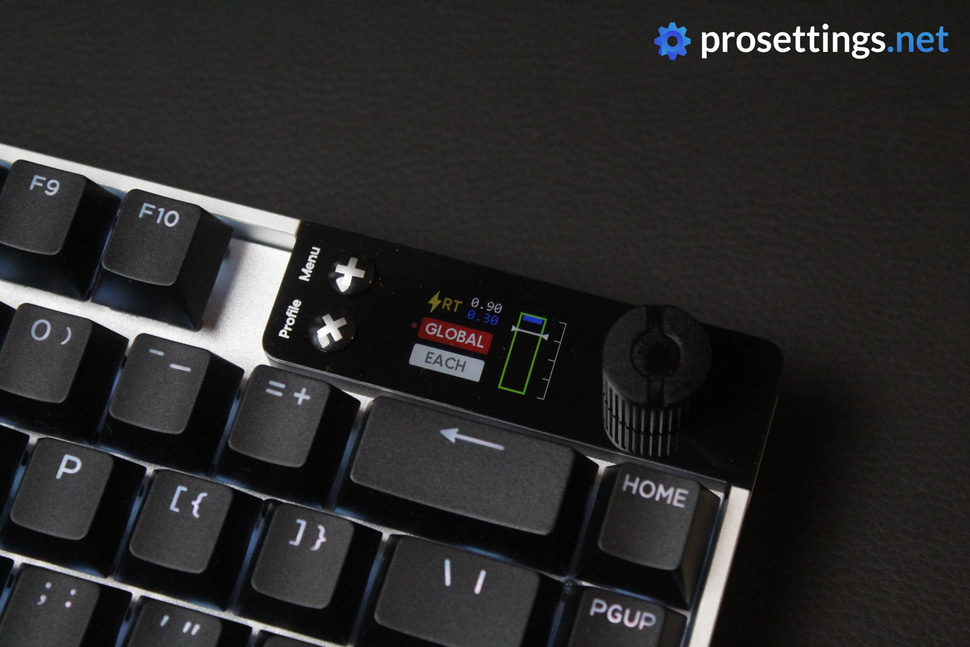
Keycaps
The stock PBT keycaps are quite simply very much okay. The font is neutral enough to fit into any setup, light comes through relatively evenly (though it’s a bit weaker at the bottom of some legends) and the caps are decently thick. They’ve got a very mild texture to them, which is just enough to prevent the keycaps from feeling gooey during intense and sweaty sessions.
I like these, and have no complaints.
Customization
The big selling point of this board is the fact that it can be customized via the LCD screen and the controls next to it. And indeed, you can configure a great deal of things here. Switching profiles is also a breeze. And thanks to the screen, you always know what you’re currently rocking without having to set up different RGB profiles and whatnot.
Sadly, you can’t configure everything with the screen. As an example: you can change the brightness of the backlighting, but you can’t change the lighting effects themselves. I would understand it if you can’t finely tune layers upon layers of lighting effects, but I would have expected presets to be available here. You can change the presets by using a button combo, but why have the screen then?
Of course, it could be argued that the screen should be easy to use, with pretty much no learning curve attached to it. And that in-depth customization to things that aren’t performance-related shouldn’t necessarily be on there. That’s a valid argument. But then I’m wondering why Pulsar wants you to download a driver program instead of just using their web-based driver (which is compatible with some of their older keyboards). Having the board customization split between three different operations (screen, button combos, software that you need to download) isn’t exactly intuitive, in my opinion.
I’m aware that this is, once again, not a performance-limiting thing, but I do find the way they’ve chosen to implement this whole thing a bit puzzling.
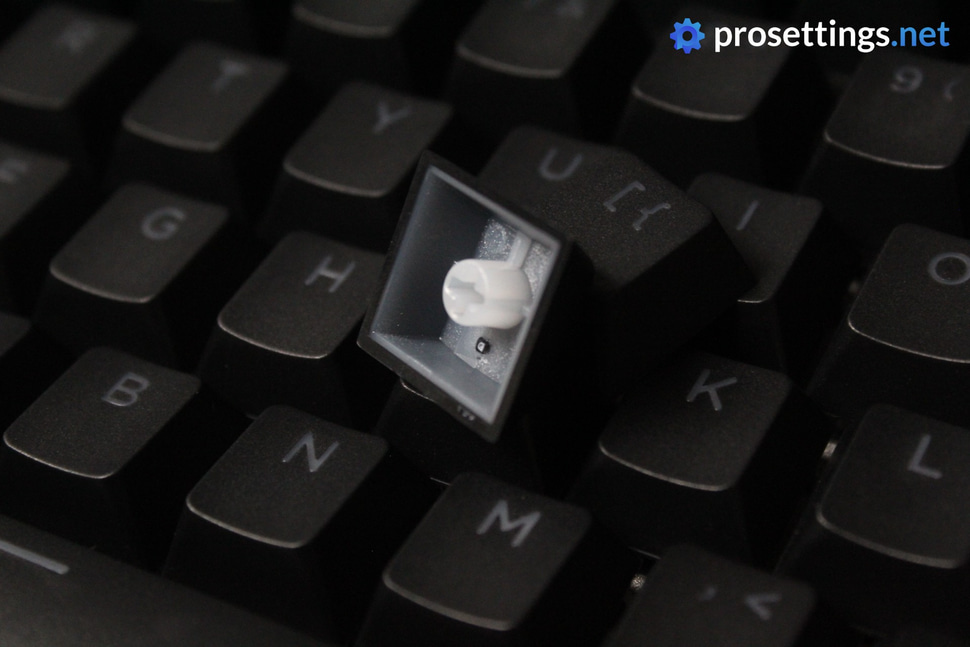
Switches
The Pulsar eS HE 70 uses Raesha magnetic switches. These feel fine to me. They’re smooth, feel very stable, and have a pleasing sound in my opinion. They also have a snappy rebounding sensation that’s not too ‘in your face’. Magnetic/analog switches have come a long way since they first hit the market, and the days where these types of switches objectively felt vastly inferior to regular mechanical switches are long behind us.
One downside of these switches is that they’re quite unique. Contrary to a lot of other options on the market, they don’t have two supporting stems on the bottom of the housing. As a result, the hot-swappable PCB also doesn’t have cutouts for these stems. This means that you can only swap these switches for other switches of this type. If you’re someone who never swaps switches, this is no problem. However, if you like to change it up every now and again, you should be aware that this severely limits your options.
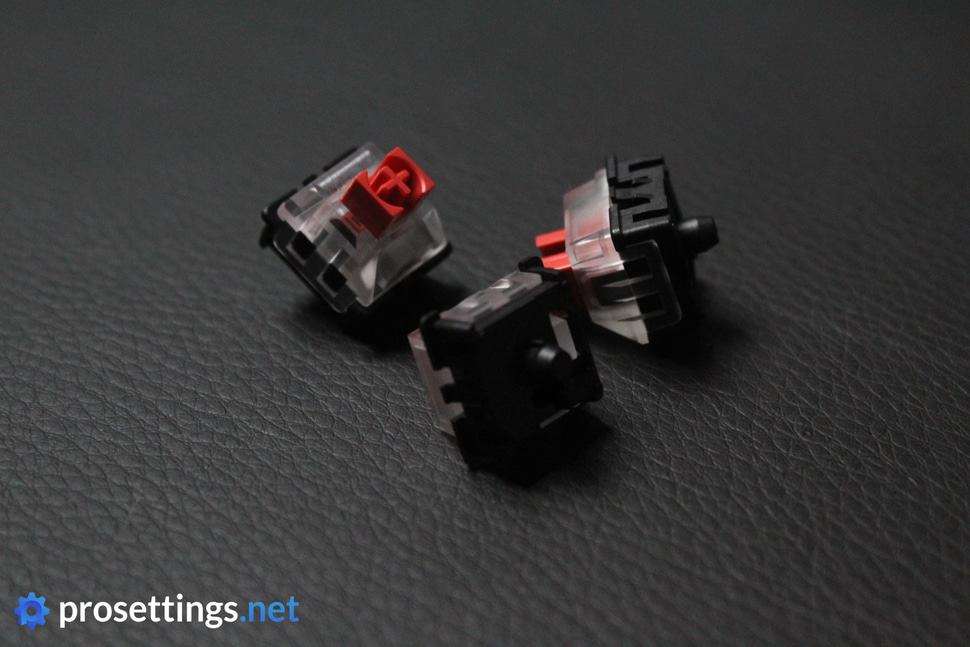
Typing and Gaming Experience
Gaming Experience
As you may know, all modern keyboards that are worth any attention at all use customizable analog switches. These allow you to use game-changing features such as Rapid Trigger to dramatically improve your movement in games, and they also allow you to set custom actuation points on a per-key basis or bind multiple actions to one keystroke. The Pulsar eS HE 70 has such switches, and the full suite of options that you’d expect from a modern gaming keyboard.
All of this technology isn’t new, so it’s important that the various features are implemented properly. As far as I can test, that’s absolutely the case here. The switches respond accurately and quickly, and with an actuation range between 0.05mm and 4.0mm, you can set these to be as light or as heavy as you want. In terms of gaming performance, this board will absolutely deliver the goods.
This particular board also has a polling rate of 8000Hz. As I’ve said before in other keyboard reviews, I like how brands push the envelope with specs and features, but I don’t feel like 8000Hz offers any kind of benefit in a keyboard. A 1000Hz scanning rate quite simply seems plenty to me on keyboards, and I highly doubt that anyone would be able to tell the difference between a 1000Hz keyboard and an 8000Hz keyboard.
This board will definitely improve your gameplay if you’re coming from a mechanical keyboard, but it won’t be because of the polling rate.
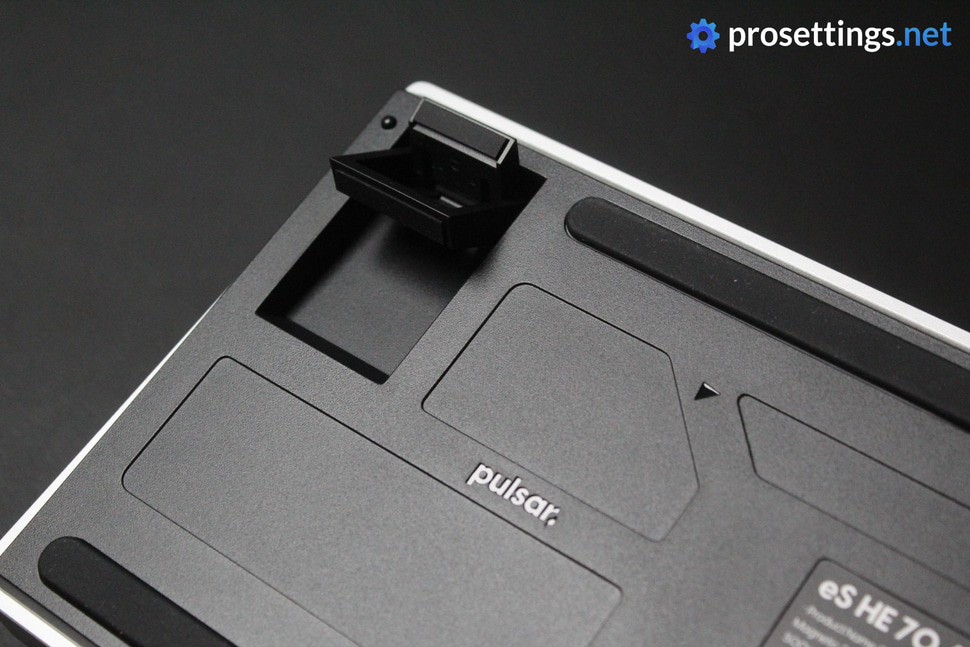
Typing Experience
With keyboard performance pretty much plateauing at this point in time, it’s important for brands to separate their products from the rest of the pack. Having a pleasant typing experience is one of the best ways to do just that.
Inside the case, Pulsar has put two silicone dampener pads, and they’ve also pre-lubed the stabilizers. Compared to what some other brands have been doing, Pulsar was pretty restrained when adding ‘mods’ to this product, but you wouldn’t really be able to tell from a sound test.
To me, this is one of the better sounding and feeling gaming keyboards on the market. The stabilizers feel and sound great, and the overall typing sound that you get out of this particular case/switch combination is very pleasing. There is some case ping when pressing certain keys near the center of the board, however. This is really only noticeable if you’re a heavy typist, but I am one of those people, so it caught my ear. Luckily, it’s not quite present enough to really bother me, but users who are sensitive to this kind of thing may want to be careful here.
The typing experience, then, is very stiff. I don’t find it to be an issue, but the solid aluminum plate does not offer any stretch whatsoever, so if you’re someone who likes a bit of flex when typing, this might not float your boat.
Sound Test
Alternatives
When considering alternatives, I would primarily compare this keyboard to other similarly sized keyboards with a screen in the top right corner. There are now so many analog keyboards that comparing each one of them in every review makes little sense if you ask me.
Considering this, I can only think of the SteelSeries Apex Pro TKL. If I had to choose between the two, I’d say that the Pulsar takes the crown. It sounds better, seems to be better constructed, and has a higher quality screen. With this, I should also be transparent and say that I have not tested the Gen-3 versions of the Apex Pro keyboards, so my experience might be outdated.
If you have any questions about how this board fares in comparison to other boards, feel free to reach out in the comments. I aim to answer every single one.
Conclusion
The Pulsar eS HE 70 is an interesting idea, but I don’t feel as if it’s fully realized. On its own, it’s a very competent gaming keyboard with good build quality and a nice, though not perfect typing experience. It has all of the bells and whistles you’d expect a modern gaming keyboard to have, and it implements them properly.
However, its defining feature lacks some impact if you ask me. The screen in the top right corner of the board looks beautiful and feels intuitive when you’re using it to customize certain settings or select profiles. But that makes it all the more frustrating that there’s nothing more to it. I would have loved it if the screen allowed you to set a custom screensaver, for example. Or if it had some cool reactive modes that responded to the way you’re using the board. As of right now, when you’re not using it, it’s simply displaying the Pulsar eS logo. A missed opportunity, if you ask me.
Beyond that, I find the customization aspect to be somewhat confusing. You cannot customize everything on the screen, for example, as some operations require a combination of buttons. If you want even more customization, you need to download software. That in itself wouldn’t be a huge deal, but Pulsar has web-based drivers for some of their keyboards, so why not for this one?
I know that the above seems nitpicky, but that’s because there aren’t very many things objectively wrong with this keyboard. It’s quite simply a well-performing, nice-sounding gaming keyboard. But it is priced at the top end of the spectrum, and being ‘just’ good isn’t enough to stand out in today’s saturated market. That’s why I would’ve loved to see the screen play a bigger role here. That would’ve been a real defining factor that even non-gamers could enjoy (keyboard fans will know what I’m talking about when I say ‘Bongo Cat’).
This product was received for free from the manufacturer and given to our reviewer to test and review. Brands and manufacturers have no editorial control over our reviews. For more information, check out our review FAQ.


